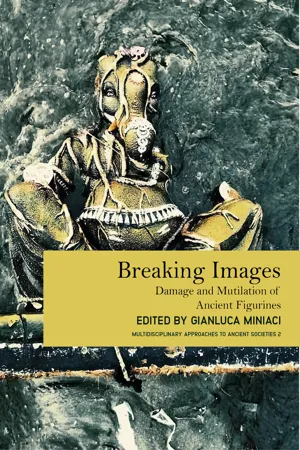
Breaking Images
Damage and Mutilation of Ancient Figurines
- 464 pages
- English
- ePUB (mobile friendly)
- Available on iOS & Android
About This Book
Archaeological remains are 'fragmented by definition' apart from exceptional cases, the study of the human past takes into account mainly traces, ruins, discards, and debris of past civilizations. It is rare that things have been preserved as they were originally made and conceived in the past. However, not all the ancient fragmentary objects were the 'leftovers' from the past. A noticeable portion of them was part and parcel of the ancient materiality already in the form of a fragment or damaged item. In 2000, John Chapman, with his volume Fragmentation in Archaeology, attracted the attention of scholars on the need to reconsider broken artifacts as the result of the deliberate anthropic process of physical fragmentation. The phenomenon of fragmentation can be thus explored with more outcomes for a category of objects that played an important role inside the society: the figurines. Due to their portability and size, figurines are particularly entangled and engaged in social, spatial, temporal, and material relations, and – more than other artifacts – can easily accommodate acts of embodiment and dismemberment. The act of creation symmetrically also involves the act of destruction, which in turn is another act of creation, since from the fragmentation comes a new entity with a different ontology. Breaking contains the paradigms of life: creation and reparation, destruction and regeneration. The scope of this volume is to search for traces of any voluntary and intentional fragmentation of ancient artifacts, creating, improving, and sharpening the methods and principles for a scientific investigation that goes beyond single author impression or sensitivity. The comparative lens adopted in this volume can allow the reader to explore different fields taken from ancient societies of how we can address, assess, detect, and even discuss the action of breaking and mutilation of ancient figurines.
Frequently asked questions
Information
Table of contents
- Front Cover
- Half-Title Page
- Title Page
- Copyright Page
- Contents
- Contributors
- Preface
- At the dawn of a break: The agency of the damage
- Beyond ritual: When the whole cracks
- The materiality of the damage: Searching for the intentionality
- Inside the fragmentation: Exploring methods and technologies
- Concluding remarks